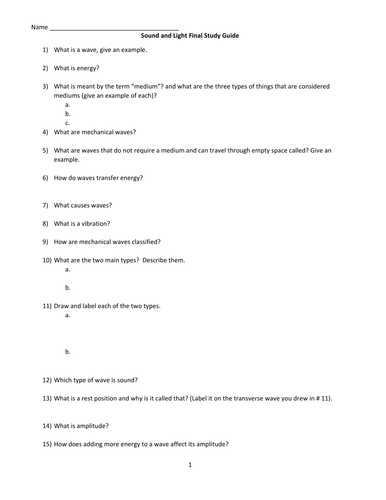

Study guide for waves unit or final exam including properties of waves, EM spectrum, and sound waves.
Accompanies the Prentice Hall Science Explorer: Sound and Light text.
Standards addressed:
4. Waves
Central Concept: Waves carry energy from place to place without the transfer of matter.
4.1 Describe the measurable properties of waves (velocity, frequency, wavelength, amplitude, period) and explain the relationships among them. Recognize examples of simple harmonic motion.
4.2 Distinguish between mechanical and electromagnetic waves.
4.3 Distinguish between the two types of mechanical waves, transverse and longitudinal.
4.4 Describe qualitatively the basic principles of reflection and refraction of waves.
4.5 Recognize that mechanical waves generally move faster through a solid than through a liquid and faster through a liquid than through a gas.
4.6 Describe the apparent change in frequency of waves due to the motion of a source or a receiver (the Doppler effect).
6. Electromagnetic Radiation
Central Concept: Oscillating electric or magnetic fields can generate electromagnetic waves over a wide spectrum.
6.1 Recognize that electromagnetic waves are transverse waves and travel at the speed of light through a vacuum.
6.2 Describe the electromagnetic spectrum in terms of frequency and wavelength, and identify the locations of radio waves, microwaves, infrared radiation, visible light (red, orange, yellow, green, blue, indigo, and violet), ultraviolet rays, x-rays, and gamma rays on the spectrum.
Accompanies the Prentice Hall Science Explorer: Sound and Light text.
Standards addressed:
4. Waves
Central Concept: Waves carry energy from place to place without the transfer of matter.
4.1 Describe the measurable properties of waves (velocity, frequency, wavelength, amplitude, period) and explain the relationships among them. Recognize examples of simple harmonic motion.
4.2 Distinguish between mechanical and electromagnetic waves.
4.3 Distinguish between the two types of mechanical waves, transverse and longitudinal.
4.4 Describe qualitatively the basic principles of reflection and refraction of waves.
4.5 Recognize that mechanical waves generally move faster through a solid than through a liquid and faster through a liquid than through a gas.
4.6 Describe the apparent change in frequency of waves due to the motion of a source or a receiver (the Doppler effect).
6. Electromagnetic Radiation
Central Concept: Oscillating electric or magnetic fields can generate electromagnetic waves over a wide spectrum.
6.1 Recognize that electromagnetic waves are transverse waves and travel at the speed of light through a vacuum.
6.2 Describe the electromagnetic spectrum in terms of frequency and wavelength, and identify the locations of radio waves, microwaves, infrared radiation, visible light (red, orange, yellow, green, blue, indigo, and violet), ultraviolet rays, x-rays, and gamma rays on the spectrum.
Something went wrong, please try again later.
This resource hasn't been reviewed yet
To ensure quality for our reviews, only customers who have purchased this resource can review it
Report this resourceto let us know if it violates our terms and conditions.
Our customer service team will review your report and will be in touch.
$3.75
